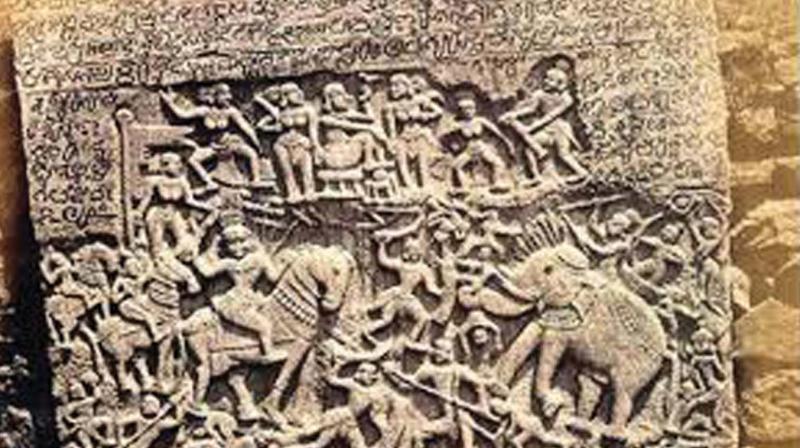Bengaluru: How enthusiast met Sheik Abdulla of 1691
The inscription also refers to the rein of Aurangajeb and how the Khasim Khan took over the fort from Shivaji’s son Sambhaji.

BENGALURU: This standalone inscription on the premises of the Doddaballapur Taluq office is one of its kind in entire Bengaluru. It has two languages inscribed on it namely the Persian and Kannada. The inscription dating back to 1267 is a living example on how the secular foundations of the country were laid down back then.
Uday Kumar P L, a corporate professional turned renowned conservator of inscriptions is now making an effort to reach this message to the society.
It is also a testimony of the fact how a 400 year old Hoysala inscription was preserved by a Mughal ruler in 1691 AD. Ephigraphia Carnataka, 1905 Edition, 9th volume written by B Lewis Rice records this inscription. Rice who translated the inscription explains in the book that, the inscription contains Persian engravings at the top in 1691 AD and Kannada engravings in the rest of 1267 AD.
Back to 1267 AD: The Persian engraving reads that, the stone was rescued from being used as building material by Sheik Abdulla, known as Farukh, renowed in India as a descendent of Sheik Farid-Ud din Masaud Chisthi Alajram in the capital of Shahjahanabad alias Delhi.
The inscription also refers to the rein of Aurangajeb and how the Khasim Khan took over the fort from Shivaji’s son Sambhaji.
The bottom in Kannada records the funding grants by swamis and settis for the repair and functioning of the Gavareshwara temple. The long scripture concludes with the intention of eternal recognition of the contributions made by various persons to the temple.
Present day: Uday Kumar is a corporate professional working in Marathalli. His passion for preservation of inscriptions in and around Bengaluru had made him one of the renowned for creating a movement in this direction.
It did not take much time to reach to this inscription after archaeologists told him that it is the only inscription in and around Bengaluru with two scriptures.
“I used to find inscriptions on streets, corners, in dilapidated buildings, but this inscription was found right in front of the entrance inside the premises of Taluq office in Doddaballapur. I was very happy to find it alright as many inscriptions don’t exist,” Uday Kumar explains.
The message of the inscription moved him as a Mughul ruler stopped the temple inscription from being used as a building material by locals. Sheik Abdulla of 1691 AD respected the intention of the inscription that the contributions of set of people to the temple should be remembered for generations and he recorded and preserved it, stresses Uday Kumar.
The inscription claims that, Doddaballapur had a fort and it also refers to Yelahanka. “We don’t know yet how the inscription was shifted to the premises of Taluq office,” he says.
Sheik Abdulla alias Farukh of 1691 AD & Gavareshwara deity of 1267 AD are speaking to Uday Kumar of love and respect that Islam and Hindu religions once cherished.
The inscriptions survived through thousands of years to tell the tale of how the foundations of secularism in our country were laid. Hello, Anyone listening?!!

